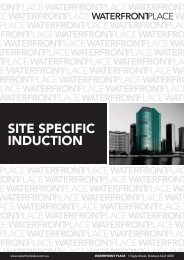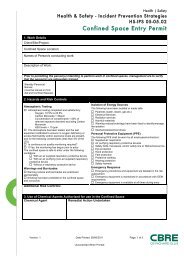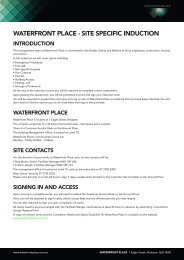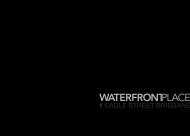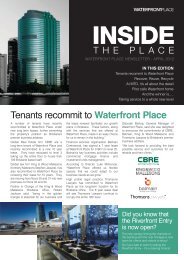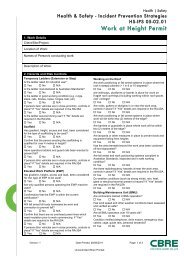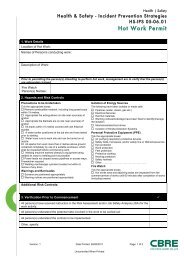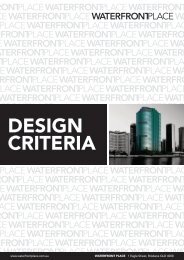Contractor Health and Safety Guidelines word - Waterfront Place
Contractor Health and Safety Guidelines word - Waterfront Place
Contractor Health and Safety Guidelines word - Waterfront Place
You also want an ePaper? Increase the reach of your titles
YUMPU automatically turns print PDFs into web optimized ePapers that Google loves.
CBRE <strong>Health</strong> <strong>and</strong> <strong>Safety</strong><br />
<strong>Contractor</strong> <strong>Health</strong> <strong>and</strong> <strong>Safety</strong> <strong>Guidelines</strong><br />
(Pacific Region)
CBRE <strong>Health</strong> <strong>and</strong> <strong>Safety</strong><br />
Table of Contents<br />
Introduction <strong>and</strong> Overview<br />
Page<br />
CBRE <strong>Health</strong> <strong>and</strong> <strong>Safety</strong> Policy 3<br />
Introduction 4<br />
General <strong>Contractor</strong> Requirements 4<br />
Induction 5<br />
<strong>Contractor</strong> <strong>Safety</strong> <strong>Guidelines</strong><br />
Page<br />
Confined Spaces 7<br />
<strong>Contractor</strong> Vehicles 7<br />
Drugs <strong>and</strong> Alcohol 7<br />
Electrical <strong>Safety</strong> 8<br />
Emergency Procedures 8<br />
Fire Protection 8<br />
First Aid 8<br />
Hazard, Incident <strong>and</strong> Injury Reporting 9<br />
Hazardous Materials 9<br />
Hazardous Substances/Dangerous Goods 9<br />
<strong>Health</strong> <strong>and</strong> <strong>Safety</strong> Performance Monitoring 9<br />
Hot <strong>and</strong> Cold Works 10<br />
Housekeeping 11<br />
Manual H<strong>and</strong>ling 11<br />
Noise 11<br />
Permits to Work 11<br />
Personal Protective Equipment 12<br />
Plant Isolation 12<br />
Plant <strong>Safety</strong> 13<br />
Restricted Access Areas 13<br />
Working At Heights 14<br />
Working with Insulated S<strong>and</strong>wich Panelling 14<br />
Appendices<br />
Page<br />
Nil<br />
<strong>Contractor</strong> Sign Off<br />
Page<br />
<strong>Health</strong> <strong>and</strong> <strong>Safety</strong> Induction SIGN OFF 16<br />
Version: 1 Date Printed: 28/06/2011 Page: 2 of 17<br />
<strong>Contractor</strong> <strong>Health</strong> <strong>and</strong> <strong>Safety</strong><br />
<strong>Guidelines</strong> (2010)<br />
Uncontrolled When Printed
CBRE <strong>Health</strong> <strong>and</strong> <strong>Safety</strong><br />
CBRE <strong>Health</strong> <strong>and</strong> <strong>Safety</strong> Policy<br />
At CBRE, we are committed to the health, safety <strong>and</strong> welfare of all our employees <strong>and</strong> to the people affected by<br />
our undertakings, including contractors, tenants <strong>and</strong> visitors. CBRE recognises that this commitment is a critical<br />
component of our overall business strategy <strong>and</strong> an important part of the value added services we offer to clients<br />
which sets us apart from our competitors.<br />
Commitments<br />
As part of our overall health <strong>and</strong> safety program, CBRE is committed to:<br />
<br />
<br />
<br />
<br />
<br />
<br />
<br />
<br />
Establishing measurable objectives <strong>and</strong> targets to ensure continued improvement aimed at eliminating work<br />
related injury <strong>and</strong> illness;<br />
Complying, where appropriate, with relevant health <strong>and</strong> safety legislation, codes of practice, st<strong>and</strong>ards <strong>and</strong><br />
guidelines applicable to CBRE;<br />
Documenting, implementing <strong>and</strong> communicating the <strong>Health</strong> <strong>and</strong> <strong>Safety</strong> Policy to all employees <strong>and</strong><br />
contractors <strong>and</strong> providing adequate resources to ensure the <strong>Health</strong> <strong>and</strong> <strong>Safety</strong> Policy is maintained;<br />
seek, value <strong>and</strong> incorporate employees opinions in relation to decision making processes impacting on<br />
workplace health <strong>and</strong> safety;<br />
Providing appropriate health <strong>and</strong> safety training to employees <strong>and</strong> designating responsibility to ensure<br />
CBRE meet set objectives;<br />
Actively promoting <strong>and</strong> developing initiatives to improve health <strong>and</strong> safety performance across CBRE<br />
Making the <strong>Health</strong> <strong>and</strong> <strong>Safety</strong> Policy readily accessible to all employees <strong>and</strong> interested parties, <strong>and</strong><br />
Periodically reviewing our entire health <strong>and</strong> safety program, including the <strong>Health</strong> <strong>and</strong> <strong>Safety</strong> Policy, to<br />
ensure it remains relevant <strong>and</strong> appropriate given the nature of our business.<br />
The key objectives of our health <strong>and</strong> safety program are to:<br />
<br />
<br />
<br />
<br />
Minimise work related injuries;<br />
Objectives<br />
Provide effective <strong>and</strong> meaningful consultation to employees regarding issues that affect their health, safety<br />
<strong>and</strong> welfare;<br />
Implement a health <strong>and</strong> safety risk management program to, where reasonably practicable, identify, assess<br />
<strong>and</strong> control all risks to the health, safety <strong>and</strong> welfare of all people affected by the undertakings of our<br />
business, <strong>and</strong><br />
Provide all employees <strong>and</strong> contractors with appropriate health <strong>and</strong> safety systems, information, training,<br />
instruction <strong>and</strong> supervision to ensure work is conducted in the safest possible manner.<br />
Authorised<br />
Tom Southern<br />
President <strong>and</strong> CEO – Australia <strong>and</strong> New Zeal<strong>and</strong><br />
Dated: 1st March, 2010<br />
Version: 1 Date Printed: 28/06/2011 Page: 3 of 17<br />
<strong>Contractor</strong> <strong>Health</strong> <strong>and</strong> <strong>Safety</strong><br />
<strong>Guidelines</strong> (2010)<br />
Uncontrolled When Printed
CBRE <strong>Health</strong> <strong>and</strong> <strong>Safety</strong><br />
INTRODUCTION<br />
CB Richard Ellis (CBRE) is committed to ensuring the health <strong>and</strong> safety of their contractors <strong>and</strong> has<br />
established a <strong>Health</strong> <strong>and</strong> <strong>Safety</strong> Management System (HSMS) to assist in meeting this commitment.<br />
The purpose of these guidelines is to provide an overview of the CBRE HSMS <strong>and</strong> contractor<br />
requirements.<br />
Please note that these guidelines are not intended to be exhaustive, nor do they seek to replace the<br />
requirement for contractors to have in place their own comprehensive health <strong>and</strong> safety policies <strong>and</strong><br />
procedures.<br />
All contractors, sub-contractors <strong>and</strong> their employees engaged by CBRE, or conducting works at<br />
CBRE managed premises or offices, are obliged to assist CBRE in complying with all statutory<br />
requirements in relation to health <strong>and</strong> safety (HS) as well as the CBRE or client specific HSMS.<br />
GENERAL CONTRACTOR REQUIREMENTS<br />
<strong>Contractor</strong> Pre-Qualification Requirements<br />
Prior to commencement of works, all contractors engaged by CBRE are required to meet the “CBRE<br />
Pre-Qualification Requirements”. In summary, the following must be provided by the contractor:<br />
<br />
<br />
<br />
<br />
<br />
Evidence of appropriate insurance cover (for example workers compensation, public liability <strong>and</strong><br />
(where appropriate) professional or products indemnity);<br />
For “major contractors” (defined below) the contractor must complete <strong>and</strong> return to CBRE the<br />
“Major <strong>Contractor</strong> Evaluation Checklist” (refer to Appendix 1);<br />
For “minor contractors” (defined below), the contractor must complete <strong>and</strong> return to CBRE the<br />
“Minor <strong>Contractor</strong> Evaluation Checklist” (refer to Appendix 2);<br />
A copy of their HS Policy <strong>and</strong> HS Management System; <strong>and</strong><br />
Copies of site specific safe work method statements (SWMS), risk assessments or job safety<br />
analyses (JSAs) relating to the works they have been engaged to perform.<br />
Definitions<br />
For the purposes of this document, the following definitions apply. If you are uncertain as to whether<br />
you are a “major” or “minor” contractor please contact CBRE who will clarify this for you.<br />
Major <strong>Contractor</strong><br />
A company where the contract may be characterised by the following:<br />
<br />
<br />
<br />
Risk: Contracts involving multiple high risk activities such as<br />
construction work <strong>and</strong> major refurbishments are classified as<br />
major. More sophisticated management systems are expected<br />
when engaging contractors to perform high risk work.<br />
Complexity: Where a contract involves the use of subcontractors,<br />
suitable systems of selection <strong>and</strong> supervision will apply to<br />
subcontractors. Where the use of subcontractors is likely, the<br />
contract should be classified as high risk.<br />
Duration: Contracts which extend beyond 1 month or are<br />
established on an ongoing basis are considered sufficiently large<br />
to expect that contractors have formalised OH&S management<br />
systems which reflect the type of work they are performing.<br />
Version: 1 Date Printed: 28/06/2011 Page: 4 of 17<br />
<strong>Contractor</strong> <strong>Health</strong> <strong>and</strong> <strong>Safety</strong><br />
<strong>Guidelines</strong> (2010)<br />
Uncontrolled When Printed
CBRE <strong>Health</strong> <strong>and</strong> <strong>Safety</strong><br />
Minor <strong>Contractor</strong><br />
A company where the contract may be characterised by the following:<br />
<br />
<br />
<br />
Risk: Contracts involving low to medium risk activities such as<br />
minor maintenance work <strong>and</strong> repairs are classified as minor. Less<br />
sophisticated management systems are expected when engaging<br />
contractors to perform low to medium risk work.<br />
Complexity: Where work is performed by a small business with no<br />
subcontractors, the level of complexity is reduced, therefore the<br />
contract is classed as minor.<br />
Duration: Contracts which are short term such as a few hours on<br />
site, or are ‘one-off’ contracts are not required to have formalised<br />
H&S management systems. However, the small business will be<br />
expected to provide CBRE with a risk assessment of the planned<br />
works.<br />
General Requirements<br />
In general contractors, sub-contractors <strong>and</strong> their employees are responsible for ensuring the<br />
following:<br />
<br />
<br />
<br />
<br />
<br />
<br />
All works are carried out in accordance with all relevant health <strong>and</strong> safety legislation, codes of<br />
practice, Australian <strong>and</strong> New Zeal<strong>and</strong> St<strong>and</strong>ards <strong>and</strong> guidance notes;<br />
They adhere to site specific policies <strong>and</strong> procedures, the requirements outlined in this document,<br />
all statutory requirements as well as their own HS policies <strong>and</strong> procedures;<br />
Providing appropriate training <strong>and</strong> supervision of their employees;<br />
Meeting the CBRE contractor prequalification requirements <strong>and</strong> providing the necessary<br />
documentation to CBRE prior to the commencement of work;<br />
In relation to CBRE managed premises or offices: making contact with the CBRE site contact<br />
prior to the commencement of work. The purpose of making such contact is to advise CBRE of<br />
when the contractor will be on site, to complete site inductions, sign attendance registers <strong>and</strong><br />
gain access keys/passes to the property etc. Where the site does not have a CBRE<br />
representative on site the contractor is responsible for ensuring they have completed a site<br />
induction <strong>and</strong> gain the necessary access keys/cards prior to commencing works at the property.<br />
Prior to commencement of work, contractors are required to identify health <strong>and</strong> safety hazards<br />
associated with the specific work being undertaken <strong>and</strong> to identify <strong>and</strong> implement appropriate<br />
control strategies.<br />
INDUCTION<br />
In relation to CBRE managed premises: prior to commencement of work on site, all contractors shall<br />
attend a site induction which may include information on the following:<br />
<br />
<br />
<br />
<br />
<br />
<br />
<br />
<br />
<br />
<br />
Review <strong>and</strong> explanation of this document<br />
Details on relevant CBRE HS policies, procedures <strong>and</strong> requirements<br />
Site emergency procedures<br />
Hazard <strong>and</strong> incident reporting procedures<br />
First aid procedures<br />
Hazards associated with the task <strong>and</strong> with the location of the task<br />
Location of hazardous materials<br />
Security <strong>and</strong> access<br />
Site specific risks<br />
Specific site hazards <strong>and</strong> requirements<br />
Version: 1 Date Printed: 28/06/2011 Page: 5 of 17<br />
<strong>Contractor</strong> <strong>Health</strong> <strong>and</strong> <strong>Safety</strong><br />
<strong>Guidelines</strong> (2010)<br />
Uncontrolled When Printed
CBRE <strong>Health</strong> <strong>and</strong> <strong>Safety</strong><br />
Inductions are required to be reviewed at least two yearly, when site conditions change significantly<br />
or contractors personnel change. In certain circumstances, face-to-face induction at remote or<br />
unattended sites is often not possible. In these cases, induction may be undertaken by providing<br />
relevant information to the contractor using alternative means, including phone, fax <strong>and</strong> email, using<br />
written information (including risk assessments <strong>and</strong> JSA’s), graphics, photographs, videos etc.<br />
Version: 1 Date Printed: 28/06/2011 Page: 6 of 17<br />
<strong>Contractor</strong> <strong>Health</strong> <strong>and</strong> <strong>Safety</strong><br />
<strong>Guidelines</strong> (2010)<br />
Uncontrolled When Printed
CBRE <strong>Health</strong> <strong>and</strong> <strong>Safety</strong><br />
CONFINED SPACES<br />
Any contractors accessing confined spaces must be appropriately qualified to access such<br />
environments. Qualified contractors engaged in works in areas classified as confined spaces shall<br />
conduct a pre-entry risk assessment prior to entering the space in question.<br />
The pre-entry risk assessment shall take into consideration the following:<br />
<br />
<br />
<br />
<br />
<br />
<br />
<br />
The nature <strong>and</strong> inherent hazards of the confined space;<br />
The work required to be done, including the need to enter the confined space;<br />
The range of methods by which the work can be done;<br />
The hazards involved <strong>and</strong> the associated risks involved with the actual method selected <strong>and</strong><br />
equipment proposed to be used;<br />
Emergency response procedures;<br />
The competence of persons to undertake the work, <strong>and</strong><br />
Selection of appropriate control measures to be taken prior to entry into the confined space.<br />
Upon the completion of the review of the pre-entry risk assessment, a confined space entry permit<br />
shall be obtained from CBRE.<br />
The confined space entry permit shall be completed accordingly <strong>and</strong> shall include:<br />
<br />
<br />
<br />
<br />
<br />
Precautions <strong>and</strong> clear instructions for the safe entry <strong>and</strong> execution of work;<br />
Confirmation that a necessary st<strong>and</strong>-by person will be present;<br />
The names of persons entering the confined space; <strong>and</strong><br />
The equipment being introduced into the confined space.<br />
Upon the completion of works, the confined space entry permit shall be completed with all<br />
persons <strong>and</strong> equipment accounted for.<br />
Under no circumstances shall confined spaces be entered without the authorisation by way of permit<br />
provide by CBRE.<br />
All work in confined spaces shall be conducted in accordance with AS 2865 Safe Working in a<br />
Confined Space.<br />
CONTRACTOR VEHICLES<br />
<strong>Contractor</strong>s bringing work vehicles onto CBRE managed properties shall observe all site speed limits<br />
where they are imposed <strong>and</strong> shall not block any access or egress points to <strong>and</strong> from the premises. All<br />
loads must be appropriately secured. All parking signage shall be adhered to where posted <strong>and</strong><br />
where required, vehicle site permits must be obtained from CBRE <strong>and</strong> displayed in the windscreen of<br />
the contractor vehicle.<br />
DRUGS AND ALCOHOL<br />
Alcohol <strong>and</strong> non-prescription drugs are not permitted onto, or to be consumed on, whilst under the<br />
engagement of CBRE, or whilst undertaking works at a CBRE managed property. Any person<br />
suspected to be under the influence or in the possession of such substances will be requested to<br />
leave the property <strong>and</strong> immediately cease works.<br />
Version: 1 Date Printed: 28/06/2011 Page: 7 of 17<br />
<strong>Contractor</strong> <strong>Health</strong> <strong>and</strong> <strong>Safety</strong><br />
<strong>Guidelines</strong> (2010)<br />
Uncontrolled When Printed
CBRE <strong>Health</strong> <strong>and</strong> <strong>Safety</strong><br />
ELECTRICAL SAFETY<br />
Immediately prior to the commencement of any work involving electrical equipment, contractors must<br />
notify CBRE to define the scope <strong>and</strong> limits of work. Work on isolated equipment must not commence<br />
without full implementation of lockout procedures (refer to the “plant isolation” section for more<br />
information).<br />
Appropriate safety tags including “danger” <strong>and</strong> “out of service tags” are to be provided by the<br />
contractors. Such tags shall only be removed by the person who originally affixed the tag or by<br />
another person under their direct instruction, provided all relevant checklists have been completed<br />
prior to removal of the tags.<br />
All electrical leads shall be connected to the nearest electrical point <strong>and</strong> not be overloaded. All power<br />
tools <strong>and</strong> leads are to be tested <strong>and</strong> tagged by a licensed electrician prior to being brought on site,<br />
<strong>and</strong> then reviewed on a monthly basis. Leads must be located <strong>and</strong> protected to prevent damage from<br />
vehicles, hot equipment, falling objects, water etc <strong>and</strong> must be fitted with earth leakage devices.<br />
Leads must be suitably positioned to ensure they do not create a trip hazard.<br />
EMERGENCY PROCEDURES<br />
Prior to commencing work on a CBRE managed premises or a CBRE office; the contractor shall<br />
inform CBRE of their presence on site. CBRE shall ensure that the contractor is appropriately<br />
inducted with regard to the site evacuation <strong>and</strong> location of emergency assembly points.<br />
Should an emergency evacuation drill occur whilst the contractor is on site, the contractor shall<br />
ensure that they follow all instructions communicated by fire wardens <strong>and</strong> participate in the<br />
emergency evacuation drill.<br />
FIRE PROTECTION<br />
Fire protection requirements must be considered prior to the commencement of work. The contractor<br />
must conduct work in a manner so as to prevent the proliferation of fire. This may involve careful<br />
selection of tools, work methods <strong>and</strong> materials. <strong>Contractor</strong>s are also responsible for ensuring<br />
flammable liquids remain closed when not in use <strong>and</strong> be stored in appropriate facilities.<br />
A Hot Work Permit is required for any activity likely to produce a source of ignition.<br />
Any impairment to Fire Services must be discussed with CBRE <strong>and</strong> a Fire Impairment Notification<br />
Form submitted.<br />
FIRST AID<br />
Prior to the commencement of work, the contractor shall ensure that provisions are available for<br />
prompt treatment in the event of an injury.<br />
In general contractors are expected to supply their own first aid equipment.<br />
In an emergency, first aid equipment may be available on site either via CBRE building management<br />
or the tenants, however, availability is not guaranteed should be confirmed prior to commencing work.<br />
Version: 1 Date Printed: 28/06/2011 Page: 8 of 17<br />
<strong>Contractor</strong> <strong>Health</strong> <strong>and</strong> <strong>Safety</strong><br />
<strong>Guidelines</strong> (2010)<br />
Uncontrolled When Printed
CBRE <strong>Health</strong> <strong>and</strong> <strong>Safety</strong><br />
HAZARD, INCIDENT AND INJURY REPORTING<br />
Any hazard or incident affecting health <strong>and</strong> safety or the environment must be reported immediately<br />
to CBRE. An incident report form is available from your CBRE contact.<br />
The contractor shall comply with the relevant state legislative requirements for reporting of incidents<br />
<strong>and</strong> accidents to the relevant health <strong>and</strong> safety regulatory body.<br />
HAZARDOUS MATERIALS<br />
Where hazardous materials are present, CBRE will provide the contractor with relevant details,<br />
location <strong>and</strong> condition of such materials. Usually, such information will be provided via the<br />
“hazardous materials register” for the property. If the site is not attended by a CBRE representative,<br />
the contractor shall seek instructions as to the location of such register.<br />
Any work on hazardous materials shall only be undertaken by an appropriately licensed <strong>and</strong> qualified<br />
contractor <strong>and</strong> in compliance with statutory requirements. If any asbestos or asbestos-like material is<br />
found or suspected, any works must cease immediately <strong>and</strong> CBRE must be contacted as soon as<br />
possible.<br />
HAZARDOUS SUBSTANCES AND DANGEROUS<br />
GOODS (HS/DGs)<br />
Where contractors are required to use, h<strong>and</strong>le <strong>and</strong>/or store dangerous goods on site, the contractor is<br />
responsible for the appropriate use, storage <strong>and</strong> safe keeping of these substances. A risk<br />
assessment must be completed in relation to all HS/DGs used by the contractor <strong>and</strong> provided to<br />
CBRE prior to the commencement of work. Where control measures have been outlined in the risk<br />
assessment, these shall be implemented on site.<br />
<strong>Contractor</strong>s are responsible for ensuring that their employees have been provided with the<br />
appropriate training for the storage <strong>and</strong> h<strong>and</strong>ling of dangerous goods. HS/DGs shall be stored,<br />
h<strong>and</strong>led <strong>and</strong> labelled in accordance with all relevant statutory requirements. Where HS/DGs are<br />
required to be stored on site <strong>and</strong> a current material safety data sheets (MSDSs) shall be made<br />
available.<br />
HEALTH AND SAFETY PERFORMANCE<br />
MONITORING<br />
Non-compliance with the requirements of these guidelines or any other site specific requirements<br />
may result in the suspension of personnel <strong>and</strong>/or termination of the contract.<br />
<strong>Contractor</strong> health <strong>and</strong> safety performance may be monitored via one or more of the following means:<br />
Inspections of the work area to ensure compliance with health <strong>and</strong> safety documentation <strong>and</strong>/or<br />
legislative requirements.<br />
<br />
<br />
Submission of reports detailing hazards, incidents <strong>and</strong> injuries occurring on the work site;<br />
Review of contractor insurances <strong>and</strong> licenses;<br />
Such monitoring may be undertaken by any contracting staff member by CBRE at any time.<br />
Version: 1 Date Printed: 28/06/2011 Page: 9 of 17<br />
<strong>Contractor</strong> <strong>Health</strong> <strong>and</strong> <strong>Safety</strong><br />
<strong>Guidelines</strong> (2010)<br />
Uncontrolled When Printed
CBRE <strong>Health</strong> <strong>and</strong> <strong>Safety</strong><br />
HOT AND COLD WORKS<br />
General Requirements<br />
Prior to the commencement of any hot <strong>and</strong>/or cold works, a risk assessment shall be completed by<br />
the contractor. Such a risk assessment must take into consideration the following (at a minimum):<br />
<br />
<br />
<br />
<br />
The nature <strong>and</strong> inherent hazards of the hot or cold work activity;<br />
The work required to be done, including the need to conduct the hot or cold work;<br />
The hazards involved <strong>and</strong> the associated risks involved with the hot or cold work <strong>and</strong> equipment<br />
proposed to be used;<br />
Fire <strong>and</strong> emergency response procedures, <strong>and</strong><br />
The competence of persons to undertake the work.<br />
Hot Works<br />
A Hot Work Permit shall be obtained from CBRE prior to engaging in any hot work. Hot work is<br />
defined as any work involving open flames producing heat <strong>and</strong>/or sparks. This includes, but is not<br />
limited to:<br />
<br />
<br />
<br />
<br />
<br />
<br />
Brazing <strong>and</strong> Soldering;<br />
Cutting.<br />
Grinding;<br />
Thawing pipe;<br />
Torching;<br />
Welding<br />
Hot work shall be undertaken in accordance with the following requirements:<br />
<br />
<br />
<br />
<br />
<br />
<br />
All equipment shall be in good repair;<br />
Ensure that all hazardous areas surrounding the hot work area are isolated or otherwise<br />
controlled so as to prevent the ignition of any materials, contaminants, agents or conditions that<br />
may be harmful to a person or property;<br />
Whilst hot work is being carried out, the contractor is to ensure that one or more fire-watch<br />
persons are present to ensure that no nearby items are ignited. The fire-watch person(s) must be<br />
assessed as being a competent person <strong>and</strong> must remain in closes proximity to the hot work area<br />
<strong>and</strong> be capable of continuous communication with the person conducting the hot work;<br />
Within 10 metres of the work the following apply:<br />
<br />
<br />
<br />
<br />
Ground swept clean of combustibles;<br />
Combustible floors <strong>and</strong> fittings wet down, covered with damp s<strong>and</strong>, metal or other shields;<br />
No combustible materials or flammable liquids shall be present;<br />
Combustible materials or liquids appropriately shielded, or<br />
Means of collecting <strong>and</strong> containing sparks is in place.<br />
When work is to be undertaken on enclosed equipment it shall be cleaned of all combustibles <strong>and</strong><br />
purged of flammable vapours;<br />
Fire extinguishing equipment shall be available for the duration of the works <strong>and</strong> at least one hour<br />
after the completion of works<br />
On completion of work, the contractor is to acknowledge in writing that the work has been completed<br />
<strong>and</strong> all persons involved in the work have left the work area safely. The fire-watch person(s) must<br />
also conduct checks of the hot works area (e.g. routine checks, security patrols etc) for 60 minutes<br />
after the work has been completed to ensure the hot work area is safe. This is to be documented on<br />
the Hot Work Permit.<br />
Version: 1 Date Printed: 28/06/2011 Page: 10 of 17<br />
<strong>Contractor</strong> <strong>Health</strong> <strong>and</strong> <strong>Safety</strong><br />
<strong>Guidelines</strong> (2010)<br />
Uncontrolled When Printed
CBRE <strong>Health</strong> <strong>and</strong> <strong>Safety</strong><br />
Welding<br />
A Hot Works Permit is required for any welding works. Gas cylinders used for oxy-acetylene or oxy-<br />
LPG welding must be securely fixed in an appropriate trolley <strong>and</strong> kept upright at all times. Welding<br />
equipment shall be fitted with flashback arresters <strong>and</strong> a fire extinguisher must be located in close<br />
proximity to welding or grinding works (persons conducting such works trained in the use of the<br />
extinguishers).<br />
Cold Works<br />
A Cold Work Permit shall be obtained from CBRE prior to engaging in any cold work.<br />
HOUSEKEEPING<br />
<strong>Contractor</strong>s shall maintain a high st<strong>and</strong>ard of housekeeping at any premises in which they are<br />
conducting works. It is the responsibility of the contractor to maintain their materials, tools <strong>and</strong> other<br />
equipment in an orderly manner on site.<br />
All debris <strong>and</strong> waste resulting from contractor activity on site shall be removed by the responsible<br />
contractor. All materials <strong>and</strong> debris must be lowered <strong>and</strong> not dropped from elevated locations <strong>and</strong><br />
platforms.<br />
All materials, tools <strong>and</strong> waste shall be located so as to reduce risks to health <strong>and</strong> safety prior to<br />
leaving the site daily. Working areas, stairways, passages <strong>and</strong> emergency exits must be kept clear of<br />
obstructions at all times. If required, working areas must be barricaded off <strong>and</strong> appropriate warning<br />
notices erected.<br />
MANUAL HANDLING<br />
Incorrect lifting techniques can cause serious injuries <strong>and</strong> accidents. Prior to the commencement of<br />
work, contractors must establish safe manual h<strong>and</strong>ling methods in accordance with state regulations.<br />
<strong>Contractor</strong>s <strong>and</strong> their employees shall be appropriately trained in their organisations safe manual<br />
h<strong>and</strong>ling methods, along with training on the use of any lifting aids provided.<br />
NOISE<br />
Noisy works are not permitted between 7.30am <strong>and</strong> 6.00 pm weekdays (excluding public holidays).<br />
Such works outside these hours must be authorised by CBRE. Notification of such works will be<br />
issued to the building occupants at the discretion of the CBRE <strong>and</strong> the property owner.<br />
The contractor is responsible for signposting work areas requiring hearing protection <strong>and</strong> for ensuring<br />
such protection is available <strong>and</strong> used by all persons entering into that area when noisy works are in<br />
progress.<br />
PERMITS TO WORK<br />
Permits to work are required prior to commencement of any of the following:<br />
<br />
<br />
<br />
<br />
<br />
<br />
Working at Heights<br />
Confined Space Entry<br />
Hot Work<br />
Cold Work<br />
Riser Access<br />
Core Holing/Chasing<br />
Version: 1 Date Printed: 28/06/2011 Page: 11 of 17<br />
<strong>Contractor</strong> <strong>Health</strong> <strong>and</strong> <strong>Safety</strong><br />
<strong>Guidelines</strong> (2010)<br />
Uncontrolled When Printed
CBRE <strong>Health</strong> <strong>and</strong> <strong>Safety</strong><br />
<br />
<br />
<br />
Working with Insulated S<strong>and</strong>wich Panelling<br />
Isolation of Fire Systems<br />
Any other specific tasks that may be specified by CBRE from time to time.<br />
The relevant permit will be provided to the contractor by CBRE. The originals are to be maintained by<br />
the contractor completing the works. A copy of the permit is to be returned at the completion of works<br />
<strong>and</strong> will be signed off by both <strong>and</strong> the contractor.<br />
PERSONAL PROTECTIVE EQUIPMENT (PPE)<br />
The contractor shall:<br />
<br />
<br />
<br />
<br />
<br />
<br />
Assess the suitability of the PPE, prior to the commencement of works, required to allow them to<br />
undertake the works safely;<br />
Outline any personal protective equipment required in the control methods on the contractor risk<br />
assessment/SWMS/JSA documents, which are submitted to CBRE prior to works;<br />
Supply PPE appropriate for the hazards identified;<br />
Supervise the use <strong>and</strong> maintenance of the PPE;<br />
Ensure that all PPE complies with current legislation, Australian St<strong>and</strong>ards <strong>and</strong> Codes of<br />
Practice; <strong>and</strong><br />
Ensure that PPE is worn in accordance with contractor’s health <strong>and</strong> safety procedures or signage<br />
throughout the property.<br />
PLANT ISOLATION<br />
General Lock Out <strong>and</strong> Tag Out (Out of Service Tags)<br />
Where plant is identified as unserviceable, faulty, requiring repairs or maintenance, or where the plant<br />
is to be isolated for an extended period, an ‘out of service’ tag is to be placed on the plant by the<br />
contractor. Should such a tag be applied by a contractor, CBRE must be immediately informed. Any<br />
repair, maintenance, inspection or modification tasks will require specific locks <strong>and</strong> tags to be applied.<br />
<strong>Contractor</strong>s are responsible for removal of such tags (if applied by them).<br />
Maintenance Lock Out <strong>and</strong> Tag Out (Danger Tags)<br />
<strong>Contractor</strong>s are to ensure plant is isolated, locked out <strong>and</strong> tagged out prior to <strong>and</strong> for the duration of<br />
any repair, maintenance, inspection or modification tasks. Sources of energy which require isolation<br />
including electrical, stored pressure, thermal, pneumatic, hydraulic, or mechanical hazards, must be<br />
monitored by the contactor for the duration of the lock out <strong>and</strong> tagged out phase.<br />
Isolation of plant <strong>and</strong> the application of locks <strong>and</strong> danger tags are to be undertaken by the contractor<br />
if they are working on the item of plant. Before work commences the isolation <strong>and</strong> lock outs are to be<br />
verified by the contractor undertaking the works for effectiveness. Before each lock <strong>and</strong> tag is<br />
removed the contractor is to verify no other person will be exposed to a hazard. Where an item of<br />
plant is left unattended (e.g. at the end of the working day) <strong>and</strong> cannot be returned to service, the<br />
plant is to remain isolated, locks <strong>and</strong> tags removed <strong>and</strong> replaced with an ‘out of service tag’ to<br />
prevent operation. Locks <strong>and</strong> tags must be re-applied when work recommences.<br />
Isolation, lock out <strong>and</strong> tag out requirements are to be identified <strong>and</strong> recorded in the relevant risk<br />
assessment <strong>and</strong> JSA’s provided by the contractor.<br />
Version: 1 Date Printed: 28/06/2011 Page: 12 of 17<br />
<strong>Contractor</strong> <strong>Health</strong> <strong>and</strong> <strong>Safety</strong><br />
<strong>Guidelines</strong> (2010)<br />
Uncontrolled When Printed
CBRE <strong>Health</strong> <strong>and</strong> <strong>Safety</strong><br />
PLANT SAFETY<br />
General Requirements<br />
<strong>Contractor</strong>s must provide, maintain <strong>and</strong> operate plant in a safe manner, complying with appropriate<br />
statutory requirements for the safe operation of plant.<br />
As a minimum, contractors shall ensure that:<br />
Inspection of plant shall be undertaken prior to commencing work on site;<br />
<br />
<br />
<br />
<br />
Risk assessments have been undertaken for all items of plant under their control;<br />
Employees of contractors required to operate or work with plant shall be instructed on the safe<br />
use of that plant <strong>and</strong> where required have the appropriate certification to operate plant;<br />
Specific items of plant requiring registration are registered in accordance with relevant State<br />
legislation;<br />
Regular inspections <strong>and</strong> maintenance is undertaken on items of plant in accordance with<br />
manufacturer’s instructions, industry st<strong>and</strong>ards <strong>and</strong> statutory requirements.<br />
In some circumstances, CBRE may request to review specific documentation relating to specific<br />
items of plant (e.g. maintenance records <strong>and</strong> documented risk assessments). The contractor shall<br />
provide this information to CBRE if requested to do so.<br />
Building Maintenance Units (BMUs)<br />
BMU’s shall only be installed, maintained <strong>and</strong> used by appropriately trained <strong>and</strong> competent persons.<br />
For additional requirements of contractors relating to BMU’s refer to Appendix 3 “BMU <strong>Contractor</strong><br />
St<strong>and</strong>ards”.<br />
Vehicles, Mobile Equipment, Mobile Scaffolding, Forklifts, Elevating Work<br />
Platforms, Scissor Lifts, Boom Lifts <strong>and</strong> Cherry Pickers<br />
In relation to this equipment, contractors must ensure the following:<br />
<br />
<br />
<br />
<br />
<br />
Load bearing capacities shall be adhered to at all times.<br />
As far as practicable, loads shall not be suspended or travel over people.<br />
Loads being transported shall be secured.<br />
Scaffolding shall comply with AS 1576 Scaffolding; be erected, maintained <strong>and</strong> dismantled by<br />
suitable qualified scaffolders.<br />
If scaffolding height exceeds 4 metres the scaffolding shall have edge protection, safe access<br />
<strong>and</strong> egress, be inspected <strong>and</strong> marked by a suitably qualified scaffolder before use, after any<br />
alteration or at intervals no greater than 30 days.<br />
RESTRICTED ACCESS AREAS<br />
From time to time, areas throughout a property, deemed to pose a health <strong>and</strong> safety risk, may be<br />
signed as “restricted access areas”. Such areas may present some hazards in common with<br />
confined spaces but do not meet all the criteria for classification as a confined space. For example,<br />
an area may have an atmosphere which contains potentially harmful levels of contaminants but it is<br />
primarily designed as a place of work.<br />
Version: 1 Date Printed: 28/06/2011 Page: 13 of 17<br />
<strong>Contractor</strong> <strong>Health</strong> <strong>and</strong> <strong>Safety</strong><br />
<strong>Guidelines</strong> (2010)<br />
Uncontrolled When Printed
CBRE <strong>Health</strong> <strong>and</strong> <strong>Safety</strong><br />
Restricted areas are not required to be managed with the same criterion as for a confined space, but<br />
do require a pre-entry risk assessment to identify the hazards, assess the risks <strong>and</strong> define risk<br />
controls. Should access be required to a restricted area, the contractor must contact CBRE.<br />
WORKING AT HEIGHTS<br />
All work where a fall of greater than 2m may occur (for example work on roofs) shall be performed in<br />
accordance with the relevant state legislation for work at height/safe work on roofs.<br />
Prior to the commencement of working at heights, a “working at heights” permit must be obtained<br />
from CBRE building management. In addition, a risk assessment must be completed by the<br />
contractor for the proposed works.<br />
Such a risk assessment must take into consideration the following:<br />
How work is done<br />
<br />
<br />
How often the task is complete<br />
The conditions or physical surroundings where such work is undertaken.<br />
Circumstances that should be considered during the assessment include:<br />
<br />
<br />
<br />
<br />
<br />
<br />
<br />
<br />
<br />
The nature, size <strong>and</strong> layout of the workplace<br />
The duration, extent <strong>and</strong> type of work to be undertaken. (Example: is just a visual check required<br />
or is installation/repair needed? How long will the job take?)<br />
What height will workers be required to access or undertake work?<br />
Training <strong>and</strong> experience of employees undertaking the work?<br />
How to get access to the work area (consider terrain, travel distance, ease of access for<br />
equipment)<br />
The number <strong>and</strong> movement of people <strong>and</strong> plant on the work site. (Example: are workers or<br />
vehicles nearby that could interfere with fall prevention measures? Do their movements cross<br />
paths with one another increasing the likelihood of a fall?)<br />
Conditions of work (Example: Is it windy or slippery? Is there poor lighting, sloping surfaces etc).<br />
The provision of appropriate fall arrest <strong>and</strong> prevention devices (i.e. those already in place <strong>and</strong><br />
those to be provided by the contractor).<br />
The provision of personal protective equipment to combat glare, thermal stress, noise or other<br />
physical hazards.<br />
The selection <strong>and</strong> use of fall arrest systems, safety mesh, scaffolding safety nets, guardrails <strong>and</strong> the<br />
selection of control measures shall be in accordance with the relevant State legislation <strong>and</strong> Codes of<br />
Practice. All ladders used on site shall comply with ANZS 1892 Portable Ladders.<br />
<strong>Contractor</strong>s shall ensure they have undergone appropriate training for the selection, use <strong>and</strong><br />
maintenance of fall arrest <strong>and</strong> prevention devices. <strong>Contractor</strong>s are also responsible for the training<br />
<strong>and</strong> instruction of their employees <strong>and</strong> shall ensure they are provided with the appropriate training.<br />
All tools, equipment <strong>and</strong> other loose items shall be affixed to the work platform or building at all times.<br />
No material shall be thrown from a height.<br />
WORKING WITH INSULATED SANDWICH<br />
PANELLING<br />
Prior to the commencement of any works involving insulated s<strong>and</strong>wich panelling (ISP), an ISP Permit<br />
must be obtained from CBRE. It is the responsibility of the contractor to ensure that the ISP Permit<br />
has been appropriate completed, any special precautions listed <strong>and</strong> the permit authorised.<br />
Version: 1 Date Printed: 28/06/2011 Page: 14 of 17<br />
<strong>Contractor</strong> <strong>Health</strong> <strong>and</strong> <strong>Safety</strong><br />
<strong>Guidelines</strong> (2010)<br />
Uncontrolled When Printed
CBRE <strong>Health</strong> <strong>and</strong> <strong>Safety</strong><br />
The following precautions must be considered prior to the issue of the ISP work permit (including but<br />
not limited to):<br />
<br />
<br />
<br />
<br />
<br />
<br />
<br />
<br />
<br />
<br />
Ensure that no hot work is being undertaken near the ISP work.<br />
Where panels need to be cut, ensure that only cold cutting methods such as shearing (h<strong>and</strong>operated<br />
tools), low speed drills or h<strong>and</strong>saws are used.<br />
Secure fixings to panels using adhesives (water based where possible) or mechanical fasteners.<br />
Where flammable adhesives must be used ensure that no hazard ignition sources (i.e. battery<br />
chargers, electrical panels or spark producing equipment) are operating within the area<br />
(approximately 3 metres).<br />
Smoking <strong>and</strong> other ignition sources are NOT PERMITTED during work on the panels.<br />
At the end of the work, ensure that any exposed core has been re-sealed with metal capping.<br />
Pipe penetrations should be sealed with a metal facia mechanically clamped onto the pipe <strong>and</strong><br />
riveted on the metal face of the panel.<br />
An air gap of 25mm should be provided around all heat generating exhaust ducts that penetrate<br />
ISP walls or ceiling with metal capping around the opening to seal the s<strong>and</strong>wich panel core.<br />
Dispose of any panel off-cuts immediately. Waste panel material (particularly cores) should be<br />
disposed of outside <strong>and</strong> stored clear of the building by more than 10 metres.<br />
A fire extinguisher is to be on h<strong>and</strong> at all times.<br />
Check that all fire protection equipment (fixed <strong>and</strong> mobile) is in good working order <strong>and</strong> that staff<br />
have received appropriate training in use of this equipment.<br />
Version: 1 Date Printed: 28/06/2011 Page: 15 of 17<br />
<strong>Contractor</strong> <strong>Health</strong> <strong>and</strong> <strong>Safety</strong><br />
<strong>Guidelines</strong> (2010)<br />
Uncontrolled When Printed
CBRE <strong>Health</strong> <strong>and</strong> <strong>Safety</strong><br />
✂<br />
<strong>Contractor</strong> <strong>Health</strong> <strong>and</strong> <strong>Safety</strong> <strong>Guidelines</strong><br />
Issued To:<br />
Name of Employee (your name):<br />
Address (your address):<br />
I acknowledge having participated in a CB Richard Ellis <strong>Contractor</strong> Induction<br />
<strong>and</strong> have received a copy of the CBRE “<strong>Contractor</strong> <strong>Health</strong> <strong>and</strong> <strong>Safety</strong><br />
<strong>Guidelines</strong>”. As a contractor of CBRE, I have read the “<strong>Contractor</strong> <strong>Health</strong> <strong>and</strong><br />
<strong>Safety</strong> <strong>Guidelines</strong>” <strong>and</strong> underst<strong>and</strong> their contents in full. I agree to abide by<br />
the conditions stated in these guidelines, health <strong>and</strong> safety legislative<br />
requirements <strong>and</strong>/or any other direction by CBRE in relation to the health <strong>and</strong><br />
safety of the site generally.<br />
<strong>Contractor</strong>(s) Signature: __________________________________________________________<br />
Date: ___________________________________________________________________________________<br />
Employer’s Name: __________________________________________________________________<br />
Issuing Officer: ______________________________________________________________________<br />
Signed: ________________________________________________________________________________<br />
* Please read <strong>and</strong> ensure your underst<strong>and</strong>ing of the booklet, then sign the above form<br />
<strong>and</strong> return to CBRE.



